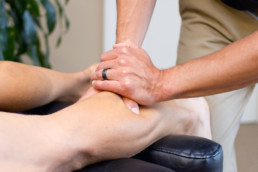Active Release Techniques
Active Release Techniques® is the global leader in non-invasive soft-tissue and nerve treatment, including treatment of strains, sprains, and other musculoskeletal disorders (MSDs). Hands-on, movement-based ART treatment is specifically designed to quickly reduce pain and restore function. Whether you’ve got a minor strain or a complex injury, ART gets you back to work and back to play faster and more effectively than conventional therapy methods.

Active Release Techniques may help the body...
Improve Motion
Quickly improves range of motion and flexibility of joint and soft tissue structures.
Drug-Free Pain Relief
Decreases pain intensity and pain pressure thresholds quickly and effectively.
Restore Function
Release fascial restrictions, entrapped nerves, vasculature and helps correct soft tissue dysfunction.
What is Active Release Techniques?
When you injure muscles, tendons or ligaments, scar tissue forms around the injury. Scar tissue is created from collagen cells found in these soft tissues. New collagen cells are formed in the wake of an injury, but they often aggregate without order, producing scars. Although scar tissue does not disappear quickly naturally, it is not permanent. Your body may use a process called remodeling to loosen and replace these collagen cell adhesions. This process may take weeks, months or years to break up without medical intervention.
Active Release Techniques uses manual manipulation to apply compressive, tensile and shear forces to address myofascial restrictions that could be leading to soft tissue dysfunction. The clinician applies deep tension at the area of dysfunction whilst the patient is instructed to actively move the tissue from a shortened to a lengthened position. By placing the contact point near the lesion and instructing the patient to move in a manner that produces a longitudinal sliding motion of soft tissues, e.g, nerves, ligaments and muscles beneath the contact point, ART is effective at restoring soft tissue dysfunction.
The Gold Standard in soft-tissue care.
Physiologic Benefits
Increase Range of Motion
Research shows that ART treatments can help improve range of motion and mobility in those with musculoskeletal disorders or following injuries (acute trauma) and episodes of chronic pain.
One study published in the Journal of Physical Therapy Science demonstrated significant changes in range of motion compared to the control group. The ART group was found to produce greater improvements overall in several of the markers compared to the control group.
Pain Relief
Several studies demonstrate that Active Release Techniques can reduce pain intensity and pain pressure thresholds post treatment.
One study conducted by the Korean Academy of Physical Therapy Rehabilitation Science found that ART helps lower symptoms of lower back pain, considered to be one of the leading sources of dysfunction among adults.
Reduces Nerve Entrapments
A study published in the Journal of Chiropractic Medicine suggest that Active Release Techniques can be an effective treatment strategy for patients with carpal tunnel syndrome, which results in limited hand mobility and often swelling or pain due to nerve compression. Following treatment, patients reported significant improvements in symptom severity and showed increases in functional status scores compared to the start of the study.
Mitochondrial Support
HBOT allows mitochondria, the batteries of our cells, to generate adenosine triphosphate, or ATP. ATP is the chemical that stores and releases energy necessary for many cellular processes and is the main energy source for our body. When you have experienced cellular damage and oxygen-carrying capacity is threatened, your body is in jeopardy of not creating enough ATP. By providing high levels of oxygen, HBOT helps optimize cellular energy production.
Neovascularization
Hyperbaric oxygen therapy stimulates the growth of new blood vessels in the body, which increases circulation, allowing revitalized tissue to thrive even after the treatment protocol has been completed.
Stem Cell Mobilization
During treatment, HBOT has the power to increase stem cells in circulation eight-fold. These stems cells already exist in the body and have the unique ability to differentiate into any type of tissue, making them a valuable tool for regeneration and healing.
What Conditions Will Benefit?
ART treatment is effective against signs and symptoms of muscle and nerve dysfunction – sometimes referred to as soft-tissue conditions or MSDs – including tightness, pain, tingling, inflammation, restricted range of motion, muscle ache, and related symptoms.
- Arthritis
- Sports Injuries
- Neck Pain (Cervical Sprain / Strain)
- Back Pain (Lumbar Sprain / Strain)
- Knee Pain (Patellofemoral Disorders)
- Ankle Pain (Achilles Tendinitis)
- Foot Pain (Plantar Fasciitis)
- Shoulder Pain (Rotator Cuff Tendinitis)
- Tennis Elbow (Lateral Epicondylitis)
- Golfer’s Elbow (Medial Epicondylitis)
- Wrist Pain (Carpal Tunnel Syndrome)
- IT Band (Iliotibial Band)
- Repetitive Stress Injuries
- TMJ
- Muscle Strains
- Ligament Sprains
- Shin Splints

Learn More About Active Release Techniques
What to Expect During Treatment
Treatment sessions last about 15-minutes and many patients experience dramatic reduction in pain and increase in range of motion after their first treatment. Most problems are resolved in five or fewer treatments. Meaning you spend less time in waiting rooms and doctor’s offices, and more time living your life.
How Many Treatments Are Recommended?
How many sessions a person needs depends on the severity of the health concern. While many people may benefit from a single session, often times more complex conditions may require more frequent treatment.